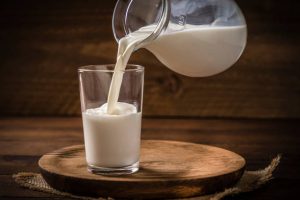Milk production up in state, poor show in 13 districts PNN Updated: April 17th, 2025, 09:36 IST in Metro , Top Stories 0 Front view of a pitcher pouring milk into a drinking glass on a rustic wooden background. Low key DSLR photo taken with Canon EOS 6D Mark II and Canon EF 24-105 mm f/4L Share on Facebook Share on Twitter Share on WhatsApp Share on Linkedin Bhubaneswar: Livestock plays a crucial role in strengthening the national economy. Especially in rural areas, many families rely on milk production for their livelihood.
India has established itself as the world’s largest milk-producing country. According to the recently released data by the Ministry of Fisheries, Animal Husbandry and Dairying, milk production in the country during the financial year 2023–24 stood at 239.3 million metric tonnes (MMT).

Odisha — nestled on the eastern coast of India and which blends tradition with agriculture– contributed 1.1 per cent to it, plac[1]ing the state at the 16th position nationally. While milk production in Odisha had been steadily increasing since 2009–10, recent data reveals a decline in 13 districts during 2023–24 compared to 2022–23.
Also Read Tunnel T-4 day lightning marks major progress 24 mins ago Suspicious death in Odisha jail leads family to claim murder 11 hours ago A drop in milk output in 43 per cent of the districts reflects the fragile condition of the rural economy. However, the recently implemented Mukhyamantri Kamdhenu Yojana by the state government is expected to improve the situation. In 2023–24, Uttar Pradesh had the highest milk production in the country with 38,780 thousand metric tonnes (TMT), whereas Odisha produced 2,636 TMT.
These two states contributed 16.21 per cent and 1.1 per cent, respectively, to the national figure.
Following Uttar Pradesh, Rajasthan pro[1]duced 34,733 TMT (14.51 per cent), Madhya Pradesh 21,326 TMT (8.91 per cent), Gujarat 18,312 TMT (7.
65 per cent), and Maharashtra 16,045 TMT (6.71 per cent). In the 2022–23 fiscal year, Odisha’s milk production was 2,476.
42 TMT. It increased by 159.58 TMT in 2023–24.
However, milk production decreased in 13 districts— Angul, Balasore, Bhadrak, Boudh, Gajapati, Jharsuguda, Kalahandi, Keonjhar, Koraput, Mayurbhanj, Nuapada, Sambalpur, and Subarnapur. Cuttack district recorded the highest milk production of 391 TMT from 14,03,204 milch animals. On the other hand, Kandhamal recorded the lowest, producing only 11.
11 TMT from 4,73,199 animals. In Mayurbhanj, despite having the highest number of milchanimals at 3,761,128, milk production was very low. The annual production dropped from 72.
87 TMT to 62.78 TMT. The presence of more indigenous cows, which produce less milk, in these 13 districts is cited as the main reason for the decline.
Animal Husbandry and Veterinary Services Director Vijay Amruta Kulange said, “Omfed currently collects 5.14 lakh litres of milk daily, out of which 2,500 litres come from indigenous cows. Private companies also collect around 2.
74 lakh litres of milk daily from the state. In total, Odisha produces nearly 8 lakh litres of milk per day. Of this, Omfed collects 5–6 lakh litres, private companies purchase some, and the rest is used for household consumption.
To encourage dairy farmers, the state government is considering giving an incentive of `2 per litre annually to Omfed’s milk suppliers. To double daily milk production and meet the per capita milk requirement, the state government has launched the Mukhyamantri Kamdhenu Yojana. Under this, 2,000 beneficiaries will annually receive two crossbred cows each to establish small dairy units.
Additionally, 20,000 dairy farmers will receive subsidised cattle feed, and 1 lakh farmers will receive assistance for cattle insurance. Kulange further mentioned that though various private companies from outside the state are selling milk in Odisha, they are not collecting milk from Odisha’s farmers. He also informed that Omfed is exporting milk and milk products to states like Chhattisgarh, West Bengal, Assam, and the northeastern states.
Experts like Sabyasachi Behera, a farming consultant, pointed out that bank loans for farmers remain insufficient, and payment rates from Omfed have not been as lucrative as farmers expect. “The financial system needs to work more efficiently to provide the necessary support to the dairy community. This includes fairer compensation and access to credit to upgrade their farms,” Behera explains.
Soubhagya Ranjan Pradhan, General Manager of Omfed, said, “The government is focusing on Artificial Insemination (AI) services, which can significantly enhance milk production.” PNN Tags: Animal Husbandry Milk production Mukhyamantri Kamdhenu Yojana Share Tweet Send Share Suggest A Correction Enter your email to get our daily news in your inbox. Leave this field empty if you're human:.
Top

Milk production up in state, poor show in 13 districts

Bhubaneswar: Livestock plays a crucial role in strengthening the national economy. Especially in rural areas, many families rely on milk production for their livelihood. India has established itself as the world’s largest milk-producing country. According to the recently released data by the Ministry of Fisheries, Animal Husbandry and Dairying, milk production in the country during [...]











-1745121369054_v.webp)